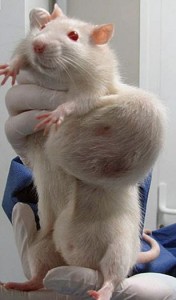
More evidence that low-calorie sweeteners are bad for your health
Studies show that artificial sweeteners can raise the risk of hypertension, metabolic syndrome, type 2 diabetes and heart disease, including stroke.

Natural Health News — They were the pictures that shocked the world. Laboratory animals riddled with tumours after consuming both GM maize and its associated herbicide Roundup
The 2012 study by Séralini et al, published in the Journal of Food and Chemical Toxicology, caused a scientific storm and triggered an orchestrated campaign by pro-GM lobbyists and scientists to discredit it. After a former Monsanto employee was appointed Associate Editor for Biotechnology at the JFCT, the study was withdrawn in a move that was universally condemned.
Now, in a virtually unprecedented action, the peer-reviewed journal Environmental Sciences Europe has republished the long-term study which looked at the chronic toxicity of Roundup herbicide and the genetically modified Roundup-tolerant maize variety NK603.
Its re-publication returns the data to the peer-reviewed literature.
The impetus for the study came from earlier Monsanto data linking its products with kidney and liver toxicology. Because that was a short-term study, Professor Séralini and his colleagues elected to extend the study to 200 days, a long time in the life of a rat compared to the short period used by Monsanto.
Toxic effects – and tumours
The results of the research confirm that the world’s best-selling pesticide, Roundup, as well as GM maize NK603 are associated with severe liver and kidney deficiencies and hormonal disturbances at low, environmentally relevant levels.
The study also reports unexpectedly high rates of tumour formation. Since the research was designed as a toxicology study, not a carcinogenicity study, firm conclusions on tumour formation could not be reached. Similar but lesser effects were observed with chronic consumption of Roundup-tolerant GM maize.
The scientists conclude these effects are associated with residues of Roundup and with the specific genetic modification of this maize. The formulations of Roundup, as well as this Roundup-tolerant GM maize, they suggest, should therefore be considered as endocrine (hormone) disruptors and should be re-evaluated for safety by health authorities.
Data available to everyone – unlike that of Monsanto
Winfried Schröder, editor of the journal Environmental Sciences Europe of the Springer Group, stated: “We want to enable a rational discussion about the study of Séralini et al by republishing it. This methodological competition is the energy necessary for any scientific progress. The sole purpose is to enable some scientific transparency and on this basis, a discussion that does not try to hide, but focuses on these needed methodological controversies.”
The researchers have published online the raw data of the study with free access for the entire scientific community. Prof Séralini concludes, “We have now answered all critics. These data belong to everyone who is concerned about human health.”
Monsanto and other biotech companies still refuse to make their data public so that it might be subjected to similar independent scrutiny.
The science speaks for itself
Several well known scientists have chimed in with their support for the republication.
Dr Michael Antoniou, a molecular geneticist based in London, commented, “Few studies would survive such intensive scrutiny by fellow scientists. The republication of the study after three expert reviews is a testament to its rigour, as well as to the integrity of the researchers.
“If anyone still doubts the quality of this study, they should simply read the republished paper. The science speaks for itself.
“If even then they refuse to accept the results, they should launch their own research study on these two toxic products that have now been in the human food and animal feed chain for many years.”
Dr Jack A Heinemann, Professor of Molecular Biology and Genetics, University of Canterbury, New Zealand, called the republication “an important demonstration of the resilience of the scientific community”.
Dr Heinemann continued, “The first publication of these results revealed some of the viciousness that can be unleashed on researchers presenting uncomfortable findings. I applaud Environmental Sciences Europe for submitting the work to yet another round of rigorous blind peer review and then bravely standing by the process and the recommendations of its reviewers, especially after witnessing the events surrounding the first publication.
“This study has arguably prevailed through the most comprehensive and independent review process to which any scientific study on GMOs has ever been subjected.
“The work provides important new knowledge that must be taken into account by the community that evaluates and reports upon the risks of genetically modified organisms, indeed upon all sources of pesticide in our food and feed chains. In time these findings must be verified by repetition or challenged by superior experimentation. In my view, nothing constructive for risk assessment or promotion of GM biotechnology has been achieved by attempting to expunge these data from the public record.”

Please subscribe me to your newsletter mailing list. I have read the
privacy statement